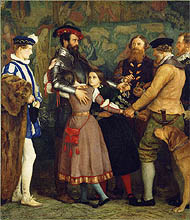Grades/Level: Lower Elementary (K–2), Upper Elementary (3–5), Middle School (6–8), High School (9–12) |
||||||
Activity Overview |
||||||
Researchers in museums have found that 30 seconds is the average amount of time visitors spend in front of works of art. After looking at a work of art it for only 30 seconds, students will use their visual recall to discuss what they noticed in order to demonstrate that really seeing and reflecting on a work of art requires time. |
||||||
Learning Objectives |
||||||
Students should be able to: |
||||||
Materials |
||||||
• pencils and paper |
||||||
|
|
||||||
Activity Steps |
||||||
1. Ask students to estimate the average amount of time they spend when looking at a work of art. Record their responses and discuss the factors they believe affect the amount of time. Ask students how long they think adults spend, on average, looking at a work of art. Record their responses and discuss why there may be a difference between an adult's and a child's looking. After students have answered, explain that researchers have discovered that the average time that adults spend looking at one object in a museum is less than 30 seconds. Are 30 seconds ample to spend with a work of art? Why or why not? Try the following experiment to test their answers. |
|
|||||
